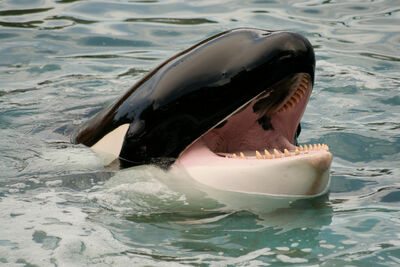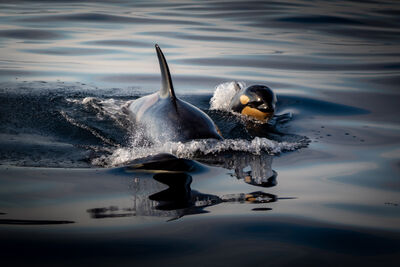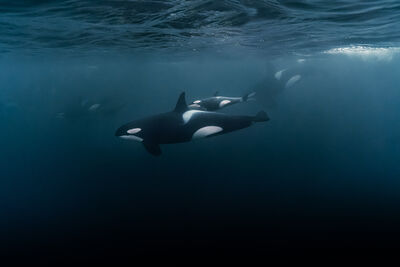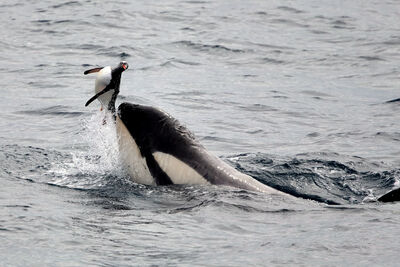Found across the world, orcas have long captivated divers and landlubbers alike. Nicknamed 'killer whales' or 'wolves of the sea,' these distinctive black-and-white predators are one of the most recognized mammals to ply the ocean. While they're best known for their ferocious hunting skills, there's more to orcas than meets the eye. They're emotionally intelligent, have good family values and even speak in different dialects. Most recently, they've also opened the debate on the ethics of keeping marine mammals in captivity. Whether you've heard the distinctive clicks of pods communicating, been lucky enough to see them cruising past on a dive or simply want to learn more about the ocean's top predator, discover our top ten orca facts.

1. Killer Whales Are Actually Dolphins
Killer whales or killer dolphins? Thanks to their whopping great size, it's easy to assume that orcas are whales. However, these mega marine mammals are the world's largest species of dolphin, belonging to the dolphin family, Delphinidae.
Adult male orcas can reach a jaw-dropping 26 feet in length and weigh up to 12,000 pounds. Adult female orcas are shorter, ranging between 16-23 feet long and weighing up to 8,000 pounds. To help you gauge just how big they are, a male orca's dorsal fin can be as tall as six feet, which is taller than most people!
2. Orcas Have Complex Societies
Orcas, like other dolphins, are very social creatures. They live in a group, or pod, which typically contains between two and 15 individuals. These pods can have more than one family and can span as many as four generations.
They also have complex social structures, with most pods existing in a matriarchal society, meaning that female orcas are the dominant sex and tend to outlive males.
Female orcas also undergo menopause; however, they continue to be vital family members, with evidence showing that young orcas in pods with maternal grandmothers have higher survival rates. This is because grandmothers will share their catch with younger members and impart wisdom on the best places to hunt.

3. There’s More Than One Type of Orca
While there's only one species of orcas, Orcinus orca, there are groups of genetically distinct orcas across the world, with as many as ten different types of orca.
Aside from being genetically different, these ecotypes have different sizes, look slightly different and exhibit distinct behaviours, such as prey preferences, dialects and foraging techniques.
For example, in the North Pacific there are three ecotypes: resident, transient and offshore orcas. When it comes to dietary requirements, resident orcas prefer eating fish like chinook salmon, transient orcas have a penchant for marine mammals and offshore orcas devour sharks.
4. Orca Clans Speak Different Languages
Orca communication consists of calls, whistles and clicks. While clicks and whistles are easy to imagine, calls can be described as discrete pulses. These calls are unique to different orca families.
Studies of resident orcas in British Columbia and Washington State found that they could be divided into four clans. Akin to having different accents, pods within these clans had different dialects. However, calls between different clans were as different from one another as Greek is to Russian.

5. Orcas Are Very Intelligent
Orcas have the second-largest brain of all marine mammals. Although their brains are structured differently than ours, an orca's brain exhibits high levels of emotional intelligence, cognition and processing.
Compared to land mammals (including humans), orcas have a highly developed paralimbic system. This is the part of the brain related to navigation and spatial memory. They also have highly developed amygdalas, which is the part of the brain linked to long-term memory and emotional learning.
6. Orcas Have No Natural Predators
Orcas are apex predators and lack any of their own natural predators. Like other dolphins, orcas hunt fish, cephalopods and crustaceans. However, these crafty predators also have other things on the menu.
They are known for hunting other marine mammals such as porpoises, whales, seals and even other dolphins. A little-known bonus orca fact: orcas also hunt great whites. Great whites will even flee an area if they sense orcas nearby, cementing killer whales as the ocean's top predator.

7. Wild Orcas Live Long Lives
Orcas can live incredibly long lives. In the wild, the average lifespan of a female is roughly 50 years, with some females living beyond 80 years. Male orcas have a shorter life span, living to an average age of 29 years, with maximum ages of between 50 and 60 years. Meanwhile, orcas in captivity have a much shorter lifespan, living for ten to 45 years. The stresses and challenges of captivity, including confined spaces, social disruptions and unnatural conditions, can contribute to the reduced lifespan of orcas in captivity compared to their counterparts in the wild.
8. Orcas Lack One Of The Five Senses
Orcas don't have a sense of smell. However, if you think about this logically, there's little use for a sense of smell in marine mammals since they spend most of their time underwater. To make up for this, killer whales have fantastic hearing and eyesight.

9. Orcas Are Top Notch Hunters
Orcas aren't called killer whales for nothing. Being apex predators, it should come as no surprise that orcas have some 'killer' adaptations.
These hunting machines can reach speeds of up to 34.8mph which, combined with their camouflaged colouring, makes them incredible at sneaking up on prey. They're black on top, helping them blend in with the inky ocean depths, while their white underbelly enables them to blend into the sunlight above.
Once they catch their prey, their interlocking teeth - comprising as many as 56 conical teeth which can be as long as four inches - makes escape futile.
10. There Are Orcas All Over the World
Although orcas are more prevalent in cooler waters, like those off Alaska and Norway, these globetrotters also frequent tropical and subtropical waters like the Sea of Cortez in Baja California. Basically, there are killer whales in all the world's oceans.












